英语三级笔译实务试卷(样题)及参考答案
CATTI三级笔译综合能力真题试卷及答案解析.doc

进入画廊的。C.permission许可,允许,后常接动词不定式。
第Hale Waihona Puke 题I''m so tired that I can''t take ________what you''re saying.
Acommon
Bgeneral
Cstaple
Dpopular
【正确答案】:C
【本题分数】:1.0分
~~~
~~
【答案解析】
近 辨析。A.common共同的,共有的;普通的,常 的;主要指共有的或共同
享受的;B.general一般的,普通的,全面的;主要指普遍性;C.staple主要
的,常用的;staplefood指主食;D.popular通俗的,流行的;因此答案C。
第5题
All students have free________to the library.
A passageway
~~~
~~
Bentrance
Cpermission
Daccess
【正确答案】:D
【本题分数】:1.0分
【答案解析】
固定搭配。have access to得以接近(或进入),享有机会。而A.passageway过道,出入口;B.entrance入口,进入;如:Police have not yet explained
the word or phrasewhich best completes eachsentence. There isonly one
right answer.)
2022年翻译三级笔译实务含答案

英语三级《笔译实务》试题Section 1:English-Chinese Translation (英译汉) (60 points)Translate the following passage into Chinese. The time for this section is 120 minutes.A few weeks back,I asked a 14-year-old friend how she was coping with school.Referring to stress,she heaved a big sigh and said:"Aiyah,anything bad that can happen has already happened."Her friends nearby then started pouring out their woes about which subjects they found hard,and so on. Pessimism again,in these all-too-familiar remarks about Singapore's education system,widely regarded as too results-oriented,and I wonder why I even bothered to ask.The school system of reaching for A's underlies the country's culture,which emphasizes the chase for economic excellence where wealth and status are must-haves.Such a culture is hard to change.So when I read of how the new Remaking Singapore Committee had set one of its goals as challenging the traditional roads to success,encouraging Singaporeans to realize alternative careers in the arts,sports,research or as entrepreneurs,I had my doubts about its success in this area,if not coupled with help from parents themselves.The new Remaking Singapore Committee is a brainchild of the Singaporean Prime Minister,formed to make Singaporeans look beyond the five C's:cash,condos,clubs,credit cards and cars,to help prepare the nation for the future.It is good that the government wants to do something about the country's preoccupation with material success. But it will be a losing battle if the family unit itself is not involved because I believe the committee's success is rooted in a revamp of an entire culture built from 37 years of independence.This makeover has to start with the most basic societal unit -- the family.Parents should not drown their children in mantras of I-want-hundred-marks. Tuition lessons are not the be-all and end-all of life. And a score of 70 for a Chinese paper is definitely not the end of life.If ever I become a parent,I will bring my children camping. I will show them that cooking food in a mess tin over a campfire is fun. I will teach them that there is nothing dirty about lying on a sleeping bag over grass.In fact,it is educational because Orion is up there in the night sky with all the other bright stars whose shapes and patterns tell something more than a myth. For instance,they give directions to the lost traveler,I will say.And who knows,my child may become an astronomer years down the road. All because of the nights I spent with him watching the twinkles in the sky.That's my point. Parents should teach their children that there's more to life than studies. Better still if the nation's leaders echo that idea as well.This way,when their children aspire to be the next Joscelin Yeo,they won't feel like they are fighting a losing battle against a society that holds doctors and lawyers in awe.However,the culture that babysits economic excellence is deeply ingrained and so are the mindsets of many parents. But parents can take the cue from the new Remaking Singapore Committee and be aware of giving their children the right kind of education.It is now wait-and-see if,say,10 years down the road,more would choose alternative careers. Hopefully,by then no one would think sportsmen or musicians as making too big a sacrifice in chasing their dreams. Section 2:Chinese-English Translation (40 points)Translate the following passage into English. The time for this section is 60 minutes.近年来,中华人民共和国政府倡导国内旅游,履行“假日经济”政策,给公民每年3次为期一周长假,让她们将更多储蓄用于旅游、购物和外出就餐。
CATTI三级笔译实务全部试题真题及答案汇总
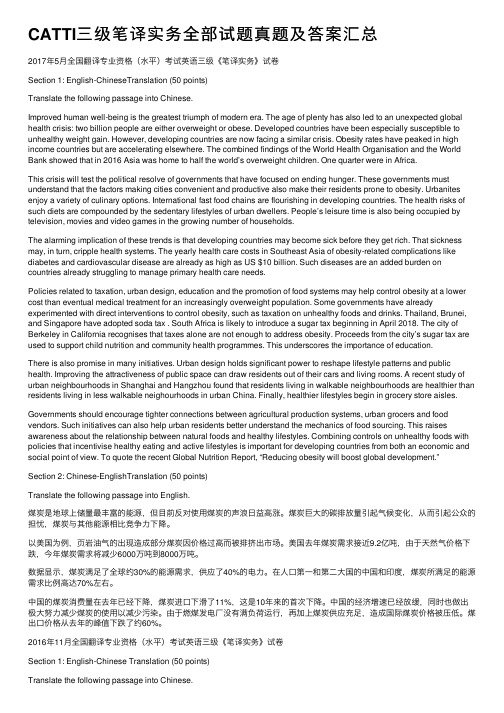
CATTI三级笔译实务全部试题真题及答案汇总2017年5⽉全国翻译专业资格(⽔平)考试英语三级《笔译实务》试卷Section 1: English-ChineseTranslation (50 points)Translate the following passage into Chinese.Improved human well-being is the greatest triumph of modern era. The age of plenty has also led to an unexpected global health crisis: two billion people are either overweight or obese. Developed countries have been especially susceptible to unhealthy weight gain. However, developing countries are now facing a similar crisis. Obesity rates have peaked in high income countries but are accelerating elsewhere. The combined findings of the World Health Organisation and the World Bank showed that in 2016 Asia was home to half the world’s overweight children. One quarter were in Africa.This crisis will test the political resolve of governments that have focused on ending hunger. These governments must understand that the factors making cities convenient and productive also make their residents prone to obesity. Urbanites enjoy a variety of culinary options. International fast food chains are flourishing in developing countries. The health risks of such diets are compounded by the sedentary lifestyles of urban dwellers. People’s leisure time is also being occupied by television, movies and video games in the growing number of households.The alarming implication of these trends is that developing countries may become sick before they get rich. That sickness may, in turn, cripple health systems. The yearly health care costs in Southeast Asia of obesity-related complications like diabetes and cardiovascular disease are already as high as US $10 billion. Such diseases are an added burden on countries already struggling to manage primary health care needs.Policies related to taxation, urban design, education and the promotion of food systems may help control obesity at a lower cost than eventual medical treatment for an increasingly overweight population. Some governments have already experimented with direct interventions to control obesity, such as taxation on unhealthy foods and drinks. Thailand, Brunei, and Singapore have adopted soda tax . South Africa is likely to introduce a sugar tax beginning in April 2018. The city of Berkeley in California recognises that taxes alone are not enough to address obesity. Proceeds from the city’s sugar tax are used to support child nutrition and community health programmes. This underscores the importance of education.There is also promise in many initiatives. Urban design holds significant power to reshape lifestyle patterns and public health. Improving the attractiveness of public space can draw residents out of their cars and living rooms. A recent study of urban neighbourhoods in Shanghai and Hangzhou found that residents living in walkable neighbourhoods are healthier than residents living in less walkable neighourhoods in urban China. Finally, healthier lifestyles begin in grocery store aisles. Governments should encourage tighter connections between agricultural production systems, urban grocers and food vendors. Such initiatives can also help urban residents better understand the mechanics of food sourcing. This raises awareness about the relationship between natural foods and healthy lifestyles. Combining controls on unhealthy foods with policies that incentivise healthy eating and active lifestyles is important for developing countries from both an economic and social point of view. To quote the recent Global Nutrition Report, “Reducing obesity will boost global development.”Section 2: Chinese-EnglishTranslation (50 points)Translate the following passage into English.煤炭是地球上储量最丰富的能源,但⽬前反对使⽤煤炭的声浪⽇益⾼涨。
2022年11月CATTI三级笔译实务真题及参考答案
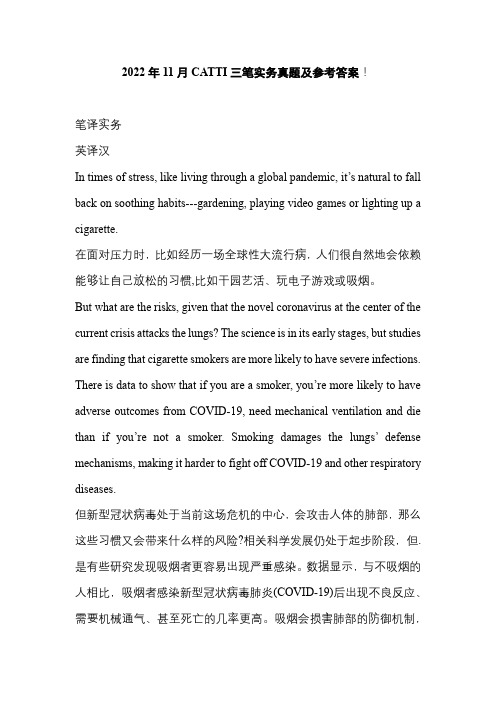
2022年11月CATTI三笔实务真题及参考答案!笔译实务英译汉In times of stress, like living through a global pandemic, it’s natural to fall back on soothing habits---gardening, playing video games or lighting up a cigarette.在面对压力时,比如经历一场全球性大流行病,人们很自然地会依赖能够让自己放松的习惯,比如干园艺活、玩电子游戏或吸烟。
But what are the risks, given that the novel coronavirus at the center of the current crisis attacks the lungs? The science is in its early stages, but studies are finding that cigarette smokers are more likely to have severe infections. There is data to show that if you are a smoker, you’re more likely to have adverse outcomes from COVID-19, need mechanical ventilation and die than if you’re not a smoker. Smoking damages the lungs’ defense mechanisms, making it harder to fight off COVID-19 and other respiratory diseases.但新型冠状病毒处于当前这场危机的中心,会攻击人体的肺部,那么这些习惯又会带来什么样的风险?相关科学发展仍处于起步阶段,但.是有些研究发现吸烟者更容易出现严重感染。
CATTI英语三级《笔译实务》真题及答案
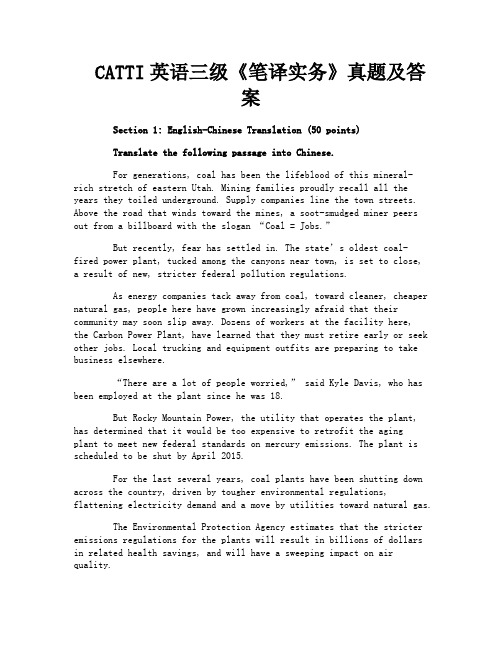
CATTI英语三级《笔译实务》真题及答案Section 1: English-Chinese Translation (50 points)Translate the following passage into Chinese.For generations, coal has been the lifeblood of this mineral-rich stretch of eastern Utah. Mining families proudly recall all the years they toiled underground. Supply companies line the town streets. Above the road that winds toward the mines, a soot-smudged miner peers out from a billboard with the slogan “Coal = Jobs.”But recently, fear has settled in. The state’s oldest coal-fired power plant, tucked among the canyons near town, is set to close,a result of new, stricter federal pollution regulations.As energy companies tack away from coal, toward cleaner, cheaper natural gas, people here have grown increasingly afraid that their community may soon slip away. Dozens of workers at the facility here,the Carbon Power Plant, have learned that they must retire early or seek other jobs. Local trucking and equipment outfits are preparing to take business elsewhere.“There are a lot of people worried,” said Kyle Davis, who has been employed at the plant since he was 18.But Rocky Mountain Power, the utility that operates the plant, has determined that it would be too expensive to retrofit the agingplant to meet new federal standards on mercury emissions. The plant is scheduled to be shut by April 2015.For the last several years, coal plants have been shutting down across the country, driven by tougher environmental regulations, flattening electricity demand and a move by utilities toward natural gas.The Environmental Protection Agency estimates that the stricter emissions regulations for the plants will result in billions of dollarsin related health savings, and will have a sweeping impact on air quality.“Coal plants are t he single largest source of dangerous carbon pollution in the United States, and we have ready alternatives like wind and solar to replace them,” said Bruce Nilles, director of the Sierra Club’s Beyond Coal campaign, which wants to shut all of the nation’s coal plants.For many here, coal jobs are all they know. The industry united the area during hard times, too, especially during the dark days after nine men died in a 2007 mining accident some 35 miles down the highway. Virtually everyone around Price knew the men, six of whom remain entombed in the mountainside.But there is quiet acknowledgment that Carbon County will have to change — if not now, soon.Pete Palacios, who worked in the mines for 43 years, has seen coal roar and fade here. Now 86, his eyes grew cloudy as he recalled his first mining job. He was 12, and earned $1 a day. “I’m retired, soI’ll be fine. But these young guys?” Pete Palacios said, his voice trailing off.Section 2: Chinese-English Translation (50 points)Translate the following passage into English.天柱县位于贵州省东部,是川渝黔通往两广、江浙的'重要门户。
2021年11月三级笔译实务真题及参考答案
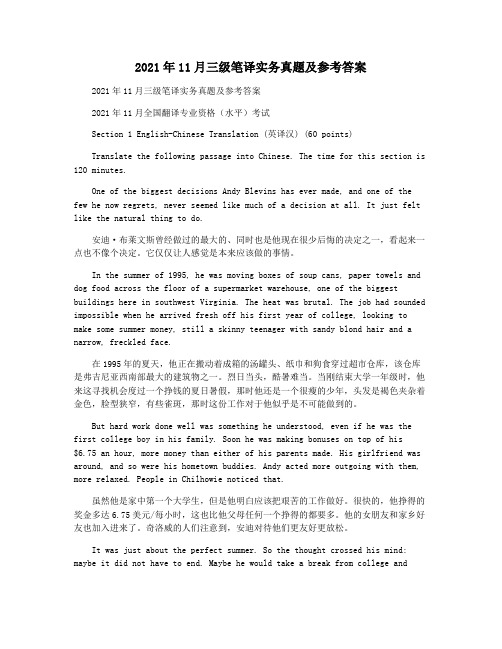
2021年11月三级笔译实务真题及参考答案2021年11月三级笔译实务真题及参考答案2021年11月全国翻译专业资格(水平)考试Section 1 English-Chinese Translation (英译汉) (60 points)Translate the following passage into Chinese. The time for this section is 120 minutes.One of the biggest decisions Andy Blevins has ever made, and one of the few he now regrets, never seemed like much of a decision at all. It just felt like the natural thing to do.安迪·布莱文斯曾经做过的最大的、同时也是他现在很少后悔的决定之一,看起来一点也不像个决定。
它仅仅让人感觉是本来应该做的事情。
In the summer of 1995, he was moving boxes of soup cans, paper towels and dog food across the floor of a supermarket warehouse, one of the biggest buildings here in southwest Virginia. The heat was brutal. The job had sounded impossible when he arrived fresh off his first year of college, looking to make some summer money, still a skinny teenager with sandy blond hair and a narrow, freckled face.在1995年的夏天,他正在搬动着成箱的汤罐头、纸巾和狗食穿过超市仓库,该仓库是弗吉尼亚西南部最大的建筑物之一。
英语翻译三级笔译实务模拟试题及答案解析(8)

英语翻译三级笔译实务模拟试题及答案解析(8)(1/1)Section ⅠEnglish Chinese TranslationTranslate the following two passages into Chinese .第1题Tourism, Globalization and Sustainable DevelopmentTourism is one of the fastest growing sectors of the global economy and developing countries are attempting to cash in on this expanding industry in an attempt to boost foreign investment and financial reserves. While conceding that the uncontrolled growth of this industry can result in serious environmental and social problems, the United Nations contends that such negative effects can be controlled and reduced.Before getting into the cold facts of global economics, let me begin with another story to warm up. I was perplexed when I recently read in the newspaper that Thailand´s forestry chief had said: "Humans can´t live in the forest because human beings aren´t animals. Unlike us, animals can. adapt themselves to the wild or any environment naturally." This was to legitimatize the government´s plan to remove hundreds of thousands of rural and hill tribe people from protected areas. This man, who is in charge of conserving the forests, is at the same time very strongly pushing to open up the country´s 81 national parks to outside investors and visitors in the name of "eco-tourism". Can we conclude, then, that the forestry chief considers developers and tourists as animals that know how to adapt to the forest and behave in the wild naturally?While authorities want to stop the access to forest lands and natural resources of village people, another group of people -- namely tourism developers and tourists with lots of money to spend -- are set to gain access to the area. While authorities believe that local people, who have often lived in the area for generations, are not capable of managing and conserving their land and natural resources -- under a community forestry scheme for example -- they believe they themselves in cooperation with the tourist industry can properly manage and conserve "nature" under a national eco-tourism plan. Taking the above quote seriously, cynics may be tempted to say there is obviously a gap between "human rights" and "animal fights".How is this story linked to globalization? First of all, that humans cannot live in the forest is -- of course -- not a Thai concept. It is a notion of Western conservation ideology -- an outcome of the globalization of ideas and perceptions. Likewise, that eco-tourism under a "good management" system is beneficial to local people and nature is also a Western concept that is being globalized. In fact, Thailand´s forestry chief thinks globally and acts locally. A lesson that can be learned from this is that the slogan "Think Globally, Act Locally" that the environmental movements have promoted all the years, has not necessarily served to preserve the environment and safeguard local communities´ rights, but has been co-opted and distorted by official agencies and private industries for profit-making purposes. The tourism industry is demonstrating this all too well Many developing countries, facing debt burdens and worsening trade terms, have turned to tourism promotion in the hope that it brings foreign exchange and investment. Simultaneously, leading international agencies such as the World Bank, United Nations agencies and business organizations like the World Travel & Tourism Council (WTTC) have been substantially involved to make tourism a truly global industry.However, tourism in developing countries is often viewed by critics as an extension of former colonial conditions because from the very beginning, it has benefited from international economic relationships that structurally favor the advanced capitalist countries in the North.Unequal trading relationships, dependence on foreign interests, and the division of labor have relegated poor countries in the South to becoming tourism recipients and affluent countries in the North to the position of tourism generators, with the latter enjoying the freedom from having to pay the price for the meanwhile well-known negative impacts in destinations. _____下一题(1/1)Section ⅡChinese-English TranslationTranslate the following passage into English .第2题中国加入WTO对国内汽车工业的影响中国的汽车工业大致可以分为两部分:中方独资公司和跨国公司控股的中国公司。
2022年11月CATTI三级笔译实务真题(附答案)
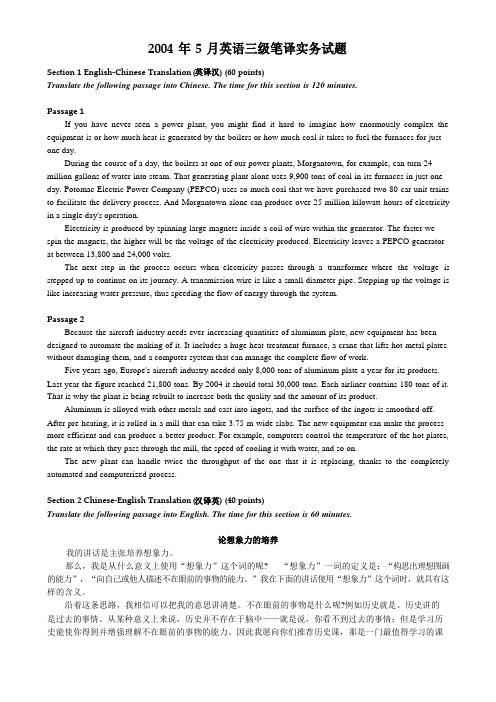
2004 年5 月英语三级笔译实务试题Section 1 English-Chinese Translation (英译汉) (60 points)Translate the following passage into Chinese. The time for this section is 120 minutes.Passage 1If you have never seen a power plant, you might find it hard to imagine how enormously complex the equipment is or how much heat is generated by the boilers or how much coal it takes to fuel the furnaces for just one day.During the course of a day, the boilers at one of our power plants, Morgantown, for example, can turn 24 million gallons of water into steam. That generating plant alone uses 9,900 tons of coal in its furnaces in just one day. Potomac Electric Power Company (PEPCO) uses so much coal that we have purchased two 80-car unit trains to facilitate the delivery process. And Morgantown alone can produce over 25 million kilowatt-hours of electricity in a single day's operation.Electricity is produced by spinning large magnets inside a coil of wire within the generator. The faster we spin the magnets, the higher will be the voltage of the electricity produced. Electricity leaves a PEPCO generator at between 13,800 and 24,000 volts.The next step in the process occurs when electricity passes through a transformer where the voltage is stepped up to continue on its journey. A transmission wire is like a small diameter pipe. Stepping up the voltage is like increasing water pressure, thus speeding the flow of energy through the system.Passage 2Because the aircraft industry needs ever-increasing quantities of aluminum plate, new equipment has been designed to automate the making of it. It includes a huge heat-treatment furnace, a crane that lifts hot metal plates without damaging them, and a computer system that can manage the complete flow of work.Five years ago, Europe's aircraft industry needed only 8,000 tons of aluminum plate a year for its products. Last year the figure reached 21,800 tons. By 2004 it should total 30,000 tons. Each airliner contains 180 tons of it. That is why the plant is being rebuilt to increase both the quality and the amount of its product.Aluminum is alloyed with other metals and cast into ingots, and the surface of the ingots is smoothed off. After pre-heating, it is rolled in a mill that can take 3.75-m-wide slabs. The new equipment can make the process more efficient and can produce a better product. For example, computers control the temperature of the hot plates, the rate at which they pass through the mill, the speed of cooling it with water, and so on.The new plant can handle twice the throughput of the one that it is replacing, thanks to the completely automated and computerized process.Section 2 Chinese-English Translation (汉译英) (40 points)Translate the following passage into English. The time for this section is 60 minutes.论想象力的培养我的讲话是主张培养想象力。
CATTI三级笔译综合能力真题和答案及解析
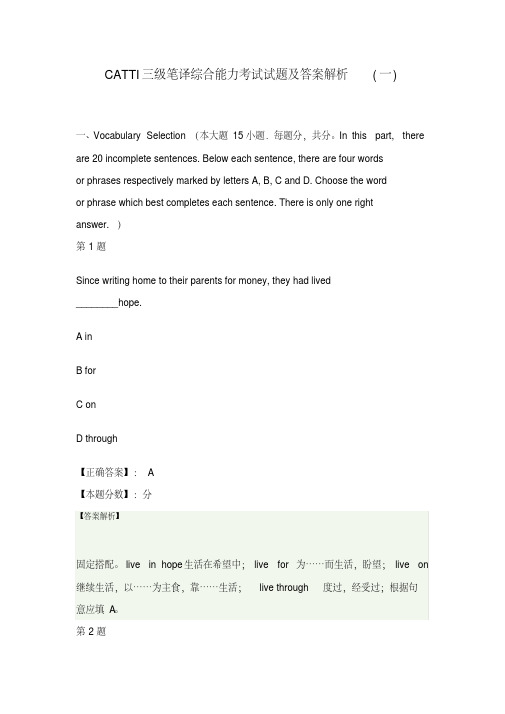
CATTI三级笔译综合能力考试试题及答案解析(一)一、Vocabulary Selection(本大题15小题.每题分,共分。
In this part, there are 20 incomplete sentences. Below each sentence, there are four wordsor phrases respectively marked by letters A, B, C and D. Choose the wordor phrase which best completes each sentence. There is only one rightanswer. )第1题Since writing home to their parents for money, they had lived________hope.A inB forC onD through【正确答案】:A【本题分数】:分【答案解析】固定搭配。
live in hope生活在希望中;live for为……而生活,盼望;live on 继续生活,以……为主食,靠……生活;live through度过,经受过;根据句意应填A。
第2题________get older, the games they play become increasingly complex.A ChildrenB Children, when theyC As childrenD For children to【正确答案】:C【本题分数】:分【答案解析】语法应用。
本句逗号前是状语从句,空白处应填连词;主句主语是the games,因此选项A、B、D均不对;只有as“随着”符合句意,所以C为答案。
第3题Martin has created enough memorable ________to make it easy to forgivehis lows.A youngstersB noblesC highsD miserables【正确答案】:C【本题分数】:分固定搭配。
CATTI三级笔译综合能力真题和答案与解析

CATTI三级笔译综合能力考试试题与答案解析<一>一、Vocabulary Selection〔本大题15小题.每题1.0分,共15.0分。
In this part, there are 20 incomplete sentences. Below each sentence, there are four words or phrases respectively marked by letters A, B, C and D. Choose the word or phrase which best completes each sentence. There is only one right answer. 〕第1题Since writing home to their parents for money, they had lived ________hope.A inB forC onD through[正确答案]:A[本题分数]:1.0分[答案解析]固定搭配。
live in hope生活在希望中;live for为……而生活,盼望;live on继续生活,以……为主食,靠……生活;live through度过,经受过;根据句意应填A。
第2题________get older, the games they play become increasingly complex.A ChildrenB Children, when theyC As childrenD For children to[正确答案]:C[本题分数]:1.0分[答案解析]语法应用。
本句逗号前是状语从句,空白处应填连词;主句主语是the games,因此选项A、B、D均不对;只有as"随着"符合句意,所以C为答案。
第3题Martin has created enough memorable ________to make it easy to forgive his lows.A youngstersB noblesC highsD miserables[正确答案]:C[本题分数]:1.0分[答案解析]固定搭配。
英语三级笔译实务试卷(样题)及参考答案

1/4全国翻译专业资格(水平)考试英语三级笔译实务试卷样题及答案英译汉样题选自2006年5月三级笔译实物英语三级笔译实务试卷(样题)Section 1:English-Chinese Translation (50 points)Translate the following passage into ChineseFreed by warming, waters once locked beneath ice are gnawing at coastal settlements around the Arctic Circle.In Bykovsky, a village of 457 residents at the tip of a fin-shaped peninsula on Russia's northeast coast, the shoreline is collapsing, creeping closer and closer to houses and tanks of heating oil,at a rate of 15 to 18 feet, or 5 to 6 meters, a year. Eventually, homes will be lost as more ice melts each summer, and maybe all of Bykovsky, too.“It is practically all ice — permafrost — and it is thawi ng. ” The 4 million Russian people who live north of the Arctic Circle are feeling the effects of warming in many ways. A changing climate presents new opportunities, but it also threatens their environment, the stability of their homes, and,for those whose traditions rely on the ice-bound wilderness, the preservation of their culture.A push to develop the North, quickened by the melting of the Arctic seas, carries its own rewards and dangers for people in the region. Discovery of vast petroleum fields in the Barents and Kara Seas has raised fears of catastrophic accidents as ships loaded with oil or liquefied gas churn through the fisheries off Scandinavia, headed for the eager markets of Europe and North America. Land that was untouched could be tainted by air and water pollution as generators, smokestacks and large vehicles sprout to support the growing energy industry.Coastal erosion is a problem in Alaska as well, forcing the United States to prepare to relocate several Inuit coastal villages at a projected cost of US $ 100 million or more for each one.Across the Arctic, indigenous tribes with cultural traditions shaped by centuries of living in extremes of cold and ice are noticing changes in weather and wildlife. They are trying to adapt, but it can be confounding.In Finnmark, the northernmost province of Norway, the Arctic landscape unfolds in late winter as an endless snowy plateau, silent but for the cries of the reindeer and the occasional whine of a snowmobile herding them.A changing Arctic is felt there, too, though in another way. "The reindeer are becoming unhappy," said Issat Eira, a 31-year-old reindeer herder.Few countries rival Norway when it comes to protecting the environment and preserving indigenous customs. The state has lavished its oil wealth on the region, and as a result Sami culture has enjoyed something of a renaissance.And yet no amount of government support can convince Eira that his livelihood, intractably entwined with the reindeer, is not about to change. Like a Texas cattleman he keeps the size of his herd secret. But he said warmer temperatures in fall and spring are melting the top layers of snow,which then refreeze as ice, making it harder for his reindeer to dig through to the lichen they eat. "The people who are making the decisions, they are living in the south and they are living in towns,”said Eira, sitting beside a birch fire inside his lavvu, a home made of reindeer hides. "They don't mark the change of weather. It is only people who live in nature and get resources from nature who mark it. ”Section 2:Chinese-English Translation (50 points)Translate the following passage into English.中国为种类繁多的菜肴感到十分自豪。
11月catti三级笔译实务真题(附答案)
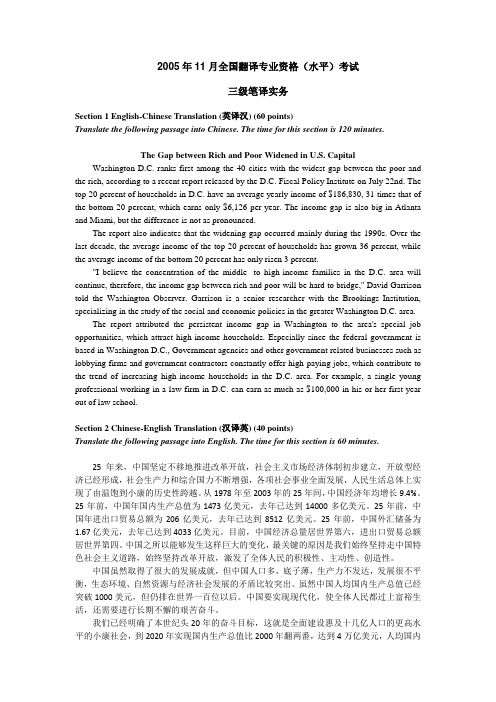
2005年11月全国翻译专业资格(水平)考试三级笔译实务Section 1 English-Chinese Translation (英译汉) (60 points)Translate the following passage into Chinese. The time for this section is 120 minutes.The Gap between Rich and Poor Widened in U.S. Capital Washington D.C. ranks first among the 40 cities with the widest gap between the poor and the rich, according to a recent report released by the D.C. Fiscal Policy Institute on July 22nd. The top 20 percent of households in D.C. have an average yearly income of $186,830, 31 times that of the bottom 20 percent, which earns only $6,126 per year. The income gap is also big in Atlanta and Miami, but the difference is not as pronounced.The report also indicates that the widening gap occurred mainly during the 1990s. Over the last decade, the average income of the top 20 percent of households has grown 36 percent, while the average income of the bottom 20 percent has only risen 3 percent."I believe the concentration of the middle- to high-income families in the D.C. area will continue, therefore, the income gap between rich and poor will be hard to bridge," David Garrison told the Washington Observer. Garrison is a senior researcher with the Brookings Institution, specializing in the study of the social and economic policies in the greater Washington D.C. area.The report attributed the persistent income gap in Washington to the area's special job opportunities, which attract high-income households. Especially since the federal government is based in Washington D.C., Government agencies and other government related businesses such as lobbying firms and government contractors constantly offer high-paying jobs, which contribute to the trend of increasing high-income households in the D.C. area. For example, a single young professional working in a law firm in D.C. can earn as much as $100,000 in his or her first year out of law school.Section 2 Chinese-English Translation (汉译英) (40 points)Translate the following passage into English. The time for this section is 60 minutes.25年来,中国坚定不移地推进改革开放,社会主义市场经济体制初步建立,开放型经济已经形成,社会生产力和综合国力不断增强,各项社会事业全面发展,人民生活总体上实现了由温饱到小康的历史性跨越。
笔译三级考试题库及答案
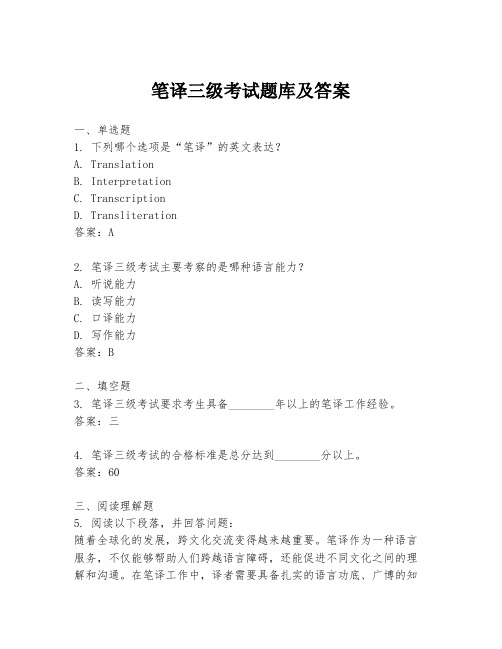
笔译三级考试题库及答案一、单选题1. 下列哪个选项是“笔译”的英文表达?A. TranslationB. InterpretationC. TranscriptionD. Transliteration答案:A2. 笔译三级考试主要考察的是哪种语言能力?A. 听说能力B. 读写能力C. 口译能力D. 写作能力答案:B二、填空题3. 笔译三级考试要求考生具备________年以上的笔译工作经验。
答案:三4. 笔译三级考试的合格标准是总分达到________分以上。
答案:60三、阅读理解题5. 阅读以下段落,并回答问题:随着全球化的发展,跨文化交流变得越来越重要。
笔译作为一种语言服务,不仅能够帮助人们跨越语言障碍,还能促进不同文化之间的理解和沟通。
在笔译工作中,译者需要具备扎实的语言功底、广博的知识面和敏锐的文化感知能力。
问题:笔译在跨文化交流中的作用是什么?答案:笔译能够帮助人们跨越语言障碍,促进不同文化之间的理解和沟通。
四、翻译题6. 将下列句子从中文翻译成英文:“随着互联网技术的发展,远程笔译工作变得越来越普遍。
”答案:"With the development of internet technology, remote translation work is becoming more and more common."7. 将下列句子从英文翻译成中文:"The role of a translator is to bridge the gap betweendifferent languages and cultures."答案:“翻译者的角色是架起不同语言和文化之间的桥梁。
”五、简答题8. 简述笔译三级考试的评分标准。
答案:笔译三级考试的评分标准主要包括译文的准确性、流畅性、完整性和专业性。
准确性要求译文忠实原文,无误译漏译;流畅性要求译文通顺自然,符合目标语言的表达习惯;完整性要求译文涵盖原文所有信息,无遗漏;专业性要求译文符合专业领域的特点和要求。
英语笔译三级试题及答案

英语笔译三级试题及答案English Translation Level 3 Exam Questions and AnswersPart I: Vocabulary and Grammar (20 points)Question 1: Choose the best word to fill in the blank.1. The company has recently undergone a significant__________ in management.- A) transformation- B) translation- C) transfusion- D) transportationAnswer 1: A) transformation2. Despite the heavy rain, the marathon was held as__________.- A) scheduled- B) scheduling- C) schedule- D) schedulesAnswer 2: A) scheduledQuestion 2: Identify the grammatical error in the following sentence and provide the correct version.- The book, which was written by my favorite author, is very interesting.Answer 2: The sentence is grammatically correct.Part II: Reading Comprehension (30 points)Passage 1:In recent years, the trend of remote working has become increasingly popular. Companies are realizing the benefits of allowing employees to work from home, including increased productivity and reduced overhead costs. However, there are also challenges associated with remote work, such as maintaining communication and ensuring data security.Question 3: According to the passage, what are the benefitsof remote working for companies?Answer 3: The benefits of remote working for companiesinclude increased productivity and reduced overhead costs.Passage 2:The invention of the internet has revolutionized the way we communicate and access information. It has made it possibleto share knowledge and ideas across the globe instantaneously. Despite its many advantages, the internet also poses certain risks, such as cybercrime and the spread of misinformation.Question 4: What are the potential risks associated with theinternet mentioned in the passage?Answer 4: The potential risks associated with the internet include cybercrime and the spread of misinformation.Part III: Translation (50 points)Question 5: Translate the following sentence from English to Chinese.- The rapid development of technology has brought about significant changes in our daily lives.Answer 5: 技术的快速发展给我们的日常生活带来了重大变化。
CATTI三级笔译实务(附答案)
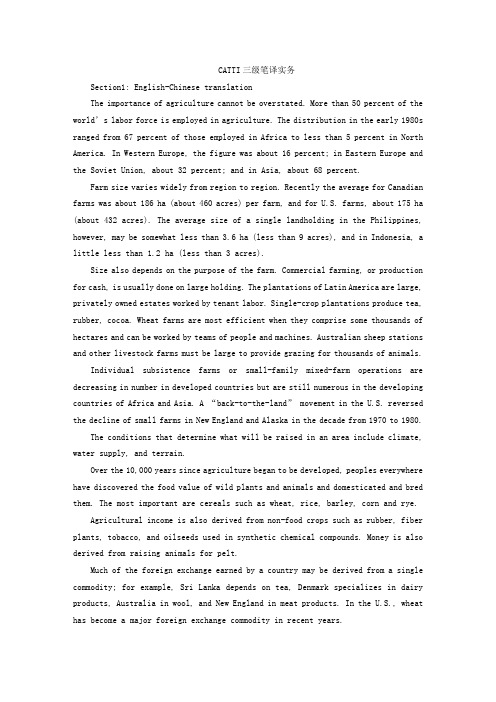
CATTI三级笔译实务Section1: English-Chinese translationThe importance of agriculture cannot be overstated. More than 50 percent of the world’s labor force is employed in agriculture. The distribution in the early 1980s ranged from 67 percent of those employed in Africa to less than 5 percent in North America. In Western Europe, the figure was about 16 percent; in Eastern Europe and the Soviet Union, about 32 percent; and in Asia, about 68 percent.Farm size varies widely from region to region. Recently the average for Canadian farms was about 186 ha (about 460 acres) per farm, and for U.S. farms, about 175 ha (about 432 acres). The average size of a single landholding in the Philippines, however, may be somewhat less than 3.6 ha (less than 9 acres), and in Indonesia, a little less than 1.2 ha (less than 3 acres).Size also depends on the purpose of the farm. Commercial farming, or production for cash, is usually done on large holding. The plantations of Latin America are large, privately owned estates worked by tenant labor. Single-crop plantations produce tea, rubber, cocoa. Wheat farms are most efficient when they comprise some thousands of hectares and can be worked by teams of people and machines. Australian sheep stations and other livestock farms must be large to provide grazing for thousands of animals.Individual subsistence farms or small-family mixed-farm operations are decreasing in number in developed countries but are still numerous in the developing countries of Africa and Asia. A “back-to-the-land” movement in the U.S. reversed the decline of small farms in New England and Alaska in the decade from 1970 to 1980.The conditions that determine what will be raised in an area include climate, water supply, and terrain.Over the 10,000 years since agriculture began to be developed, peoples everywhere have discovered the food value of wild plants and animals and domesticated and bred them. The most important are cereals such as wheat, rice, barley, corn and rye.Agricultural income is also derived from non-food crops such as rubber, fiber plants, tobacco, and oilseeds used in synthetic chemical compounds. Money is also derived from raising animals for pelt.Much of the foreign exchange earned by a country may be derived from a single commodity; for example, Sri Lanka depends on tea, Denmark specializes in dairy products, Australia in wool, and New England in meat products. In the U.S., wheat has become a major foreign exchange commodity in recent years.The importance of an individual country as an exporter of agricultural products depends on many variables. Among them is the possibility that the county is too little developed industrially to produce manufactured goods in sufficient quantity or technical sophistication. Such agricultural exporters include Ghana with cocoa, and Myanmar with rice. On the other hand, an exceptionally well-developed country may produce surpluses not needed by its own population; this as been true of the U.S., Canada, and some of the West European countries.Section2: Chinese-English translation由于西藏地处“世界屋脊”,自然条件恶劣,也由于几百年落后的封建农奴制社会形成的各种社会历史条件内的限制,西藏在全国还属于不发达地区。
2022年11月翻译资格考试三级英语笔译实务真题及答案2
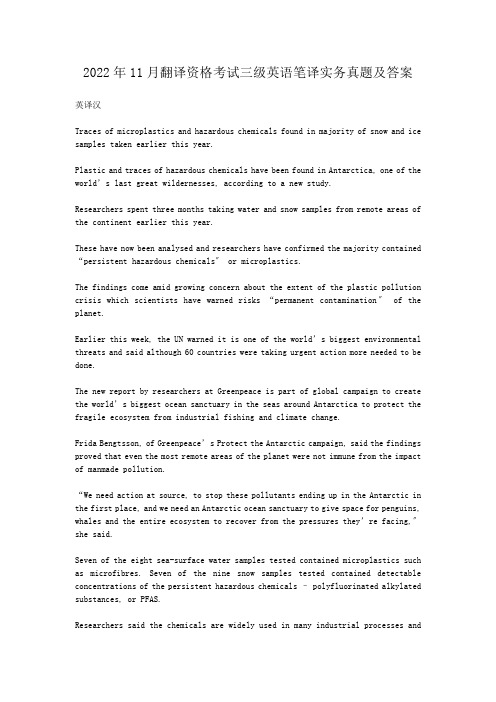
2022年11月翻译资格考试三级英语笔译实务真题及答案英译汉Traces of microplastics and hazardous chemicals found in majority of snow and ice samples taken earlier this year.Plastic and traces of hazardous chemicals have been found in Antarctica, one of the world’s last great wil dernesses, according to a new study.Researchers spent three months taking water and snow samples from remote areas of the continent earlier this year.These have now been analysed and researchers have confirmed the majority contained “persistent hazardo us chemicals〞 or microplastics.The findings come amid growing concern about the extent of the plastic pollution crisis which scientists have warned risks “permanent contamination〞of the planet.Earlier this week, the UN warned it is one of the world’s biggest environmental threats and said although 60 countries were taking urgent action more needed to be done.The new report by researchers at Greenpeace is part of global campaign to create the world’s biggest ocean sanctuary in the seas around Antarcti ca to protect the fragile ecosystem from industrial fishing and climate change.Frida Bengtsson, of Greenpeace’s Protect the Antarctic campaign, said the findings proved that even the most remote areas of the planet were not immune from the impact of manmade pollution.“We need action at source, to stop these pollutants ending up in the Antarctic in the first place, and we need an Antarctic ocean sanctuary to give space for penguins, whales and the entire ecosystem to recover from the pressures they’re fa cing,〞she said.Seven of the eight sea-surface water samples tested contained microplastics such as microfibres. Seven of the nine snow samples tested contained detectable concentrations of the persistent hazardous chemicals – polyfluorinated alkylated substances, or PFAS.Researchers said the chemicals are widely used in many industrial processes andconsumer products and have been linked to reproductive and developmental issues in wildlife. They said the snow samples gathered included freshly fallen snow, suggesting the hazardous chemicals had come from contaminated rain or snowfall.Prof Alex Rogers, a specialist in sustainable oceans at the Oxford Martin school, Oxford University, said the discovery of plastics and chemicals in Antarctica confirmed that manmade pollutants were now affecting ecosystems in every corner of the world.And he warned the consequences of this pervasive contamination remained largely unknown.“The big question now is what are the actual consequences of finding this stuff here? Many of these chemicals are pretty nasty and as they move up the food chain they may be having serious consequences for the health of wildlife, and ultimately humans. The effects of microplastics on marine life, likewise, are largely not understood,〞 he said.There is relatively little data on the extent of microplastics in Antarctic waters, and researchers said they hoped this new study would lead to a greater understanding of the global extent of plastic and chemical pollutants.Bengtsson said: “Pla stic has now been found in all corners of our oceans, from the Antarctic to the Arctic and at the deepest point of the ocean, the Mariana trench. We need urgent action to reduce the flow of plastic into our seas and we need large-scale marine reserves –like a huge Antarctic ocean sanctuary which over 1.6m people are calling for –to protect marine life and our oceans for future generations.〞参考答案:在今年早些时候采集的大部分冰雪样本中发现了微量塑料和有害化学物质。
最新CATTI三级笔译实务全部试题真题及答案汇总

C A T T I三级笔译实务全部试题真题及答案汇总------------------------------------------作者xxxx------------------------------------------日期xxxx2017年5月全国翻译专业资格(水平)考试英语三级《笔译实务》试卷Section 1: English—ChineseTranslation (50 points)Translate the following passage into Chinese。
Improved humanwell—beingis thegreatest triumph of modern era.The ageof plenty has also led to an unexpected global health crisis: two billion people are eitheroverweight or obese. Developed countries have been especiallysusceptible to unhealthy weight gain。
However, developing cou ntriesare now facing a similarcrisis。
Obesity rates have peaked in highincome countriesbut are accelerating elsewhere。
Thecombined findings of the World Health Organisationand the World Bank showed that in 2016 Asia was home to half the world’soverweight children。
Onequarter werein Africa。
- 1、下载文档前请自行甄别文档内容的完整性,平台不提供额外的编辑、内容补充、找答案等附加服务。
- 2、"仅部分预览"的文档,不可在线预览部分如存在完整性等问题,可反馈申请退款(可完整预览的文档不适用该条件!)。
- 3、如文档侵犯您的权益,请联系客服反馈,我们会尽快为您处理(人工客服工作时间:9:00-18:30)。
全国翻译专业资格(水平)考试英语三级笔译实务试卷样题及答案英译汉样题选自2006年5月三级笔译实物英语三级笔译实务试卷(样题)Section 1:English-Chinese Translation (50 points)Translate the following passage into ChineseFreed by warming, waters once locked beneath ice are gnawing at coastal settlements around the Arctic Circle.In Bykovsky, a village of 457 residents at the tip of a fin-shaped peninsula on Russia's northeast coast, the shoreline is collapsing, creeping closer and closer to houses and tanks of heating oil,at a rate of 15 to 18 feet, or 5 to 6 meters, a year. Eventually, homes will be lost as more ice melts each summer, and maybe all of Bykovsky, too.“It is practically all ice — permafrost —and it is thawing. ” The 4 million Russian people who live north of the Arctic Circle are feeling the effects of warming in many ways. A changing climate presents new opportunities, but it also threatens their environment, the stability of their homes, and,for those whose traditions rely on the ice-bound wilderness, the preservation of their culture.A push to develop the North, quickened by the melting of the Arctic seas, carries its own rewards and dangers for people in the region. Discovery of vast petroleum fields in the Barents and Kara Seas has raised fears of catastrophic accidents as ships loaded with oil or liquefied gas churn through the fisheries off Scandinavia, headed for the eager markets of Europe and North America. Land that was untouched could be tainted by air and water pollution as generators, smokestacks and large vehicles sprout to support the growing energy industry.Coastal erosion is a problem in Alaska as well, forcing the United States to prepare to relocate several Inuit coastal villages at a projected cost of US $ 100 million or more for each one. Across the Arctic, indigenous tribes with cultural traditions shaped by centuries of living in extremes of cold and ice are noticing changes in weather and wildlife. They are trying to adapt, but it can be confounding.In Finnmark, the northernmost province of Norway, the Arctic landscape unfolds in late winter as an endless snowy plateau, silent but for the cries of the reindeer and the occasional whine of a snowmobile herding them.A changing Arctic is felt there, too, though in another way. "The reindeer are becoming unhappy," said Issat Eira, a 31-year-old reindeer herder.Few countries rival Norway when it comes to protecting the environment and preserving indigenous customs. The state has lavished its oil wealth on the region, and as a result Sami culture has enjoyed something of a renaissance.And yet no amount of government support can convince Eira that his livelihood, intractably entwined with the reindeer, is not about to change. Like a Texas cattleman he keeps the size of his herd secret. But he said warmer temperatures in fall and spring are melting the top layers of snow,which then refreeze as ice, making it harder for his reindeer to dig through to the lichen they eat."The people who are making the decisions, they are living in the south and they are living in towns,”said Eira, sitting beside a birch fire inside his lavvu, a home made of reindeer hides. "They don't mark the change of weather. It is only people who live in nature and get resourcesfrom nature who mark it. ”Section 2:Chinese-English Translation (50 points)Translate the following passage into English.中国为种类繁多的菜肴感到十分自豪。
饮食是中国文化的一大要素。
中国共有8大菜系,包括辛辣的川菜和清淡的粤菜。
中国餐馆在世界各地很受欢迎。
然而,中国人的生活方式日益变化,无论是自己下厨还是上餐馆,都出现了全新的饮食习惯。
在一些传统的中国菜中,添加了奶酪和番茄酱。
城市消费者频繁地光顾一些快餐连锁店,包括麦当劳、肯德基和必胜客。
市场调查显示,在未来几年里,西式快餐的消费在中国将以每年超过45%的速度持续增长,而中式快餐店有望增加15%。
收入的不断增长,对国际食品更多的了解,加上超市购物的便捷,使中国出现了更乐于尝试包装及罐装食品的新一代消费者。
随着越来越多的家庭拥有冰箱,超市的冷冻食品不断增加,从速冻饺子到炸薯条应有尽有。
绿色有机食品也出现在大城市的商店里,但价格可能比传统产品贵很多。
由于生活方式的变化,越来越多的中国人不愿每天都采购食品。
这使包装食品更容易为大众所接受。
随着有车族的增加和新城区的涌现,超市更是日益流行。
英语三级笔译实务试卷(样题)参考答案Section 1:英译汉(50 分)气候变暖,原来压在冰层下面的水自由流动,正侵蚀着北极圈附近沿岸的居民点。
毕考夫斯基村是一个有457 口人的村庄,地处俄罗斯东北部沿海一个鳍形半岛的顶端。
那里的海岸正在崩溃,离房屋和取暖用油的油罐越来越近,后撤的速度是每年18英尺,即5-6米。
每年夏季,冰继续融化,最后家园将会消失,整个毕考夫斯基村可能也将不复存在。
“几乎到处是冰——永冻土——现在却在融化。
”生活在北极圈以北的400万俄罗斯人在许多方面感受到气候变暧的影响。
气候变化带来新的机遇,但同时也威胁着他们的环境,定,对那些以冰雪荒原为其传统之根基的人来说,也威胁着他们文化的生存。
开发北方的步伐因北极海域的冰融化而加快。
这对当地百姓来说,既会带来好处,也会带来危险。
巴伦支海和喀拉海大油田的发现增加了人们对灾难性事故的恐惧,因为不断有满载石油或液化气的船只穿过斯堪的纳维亚半岛沿海的渔场,驶往望眼欲穿的欧洲和北美市场。
随着发电机、大烟囱和大型运输工具不断涌现,以支持能源工业的发展,过去人迹罕见的地方可能会遭受空气和水污染。
海岸的侵蚀在阿拉斯加也是一个问题,迫使美国准备将沿岸好几处因纽特人的村庄迁往他处,估计每迁一个村子要耗资一亿美元。
在北极圈内,当地部落数百年来生活在严寒与冰雪之中,并形成了自己的文化传统。
现在他们感受到气候和野生动物的变化,试图适应这种状况,但不知如何是好。
在挪威最北边的芬马克省,北极风光在冬末展现出来,是一望无际的冰雪高原,一片寂静,只能听到驯鹿的叫声,和偶尔传来的放牧人摩托雪橇的嗡嗡声。
